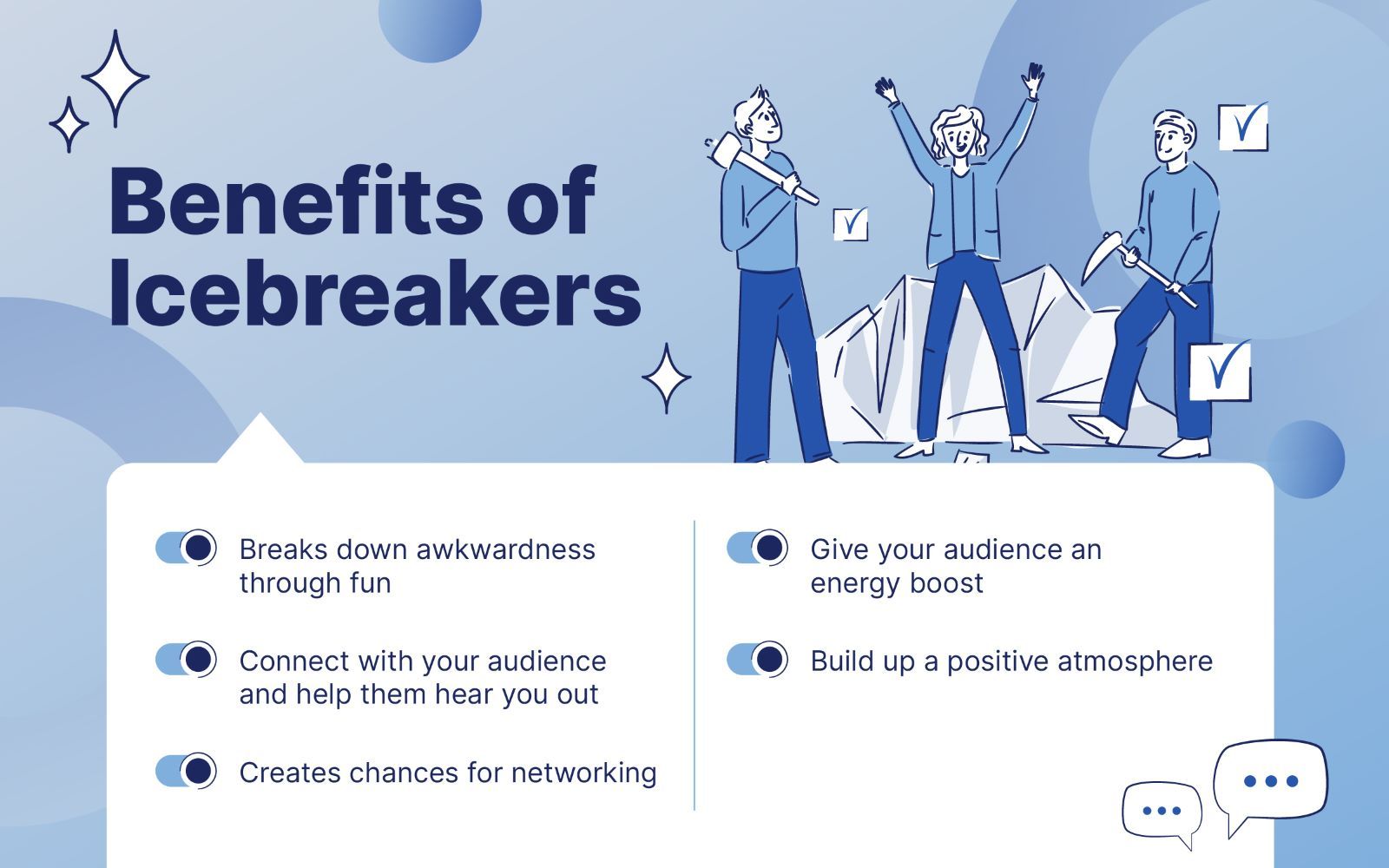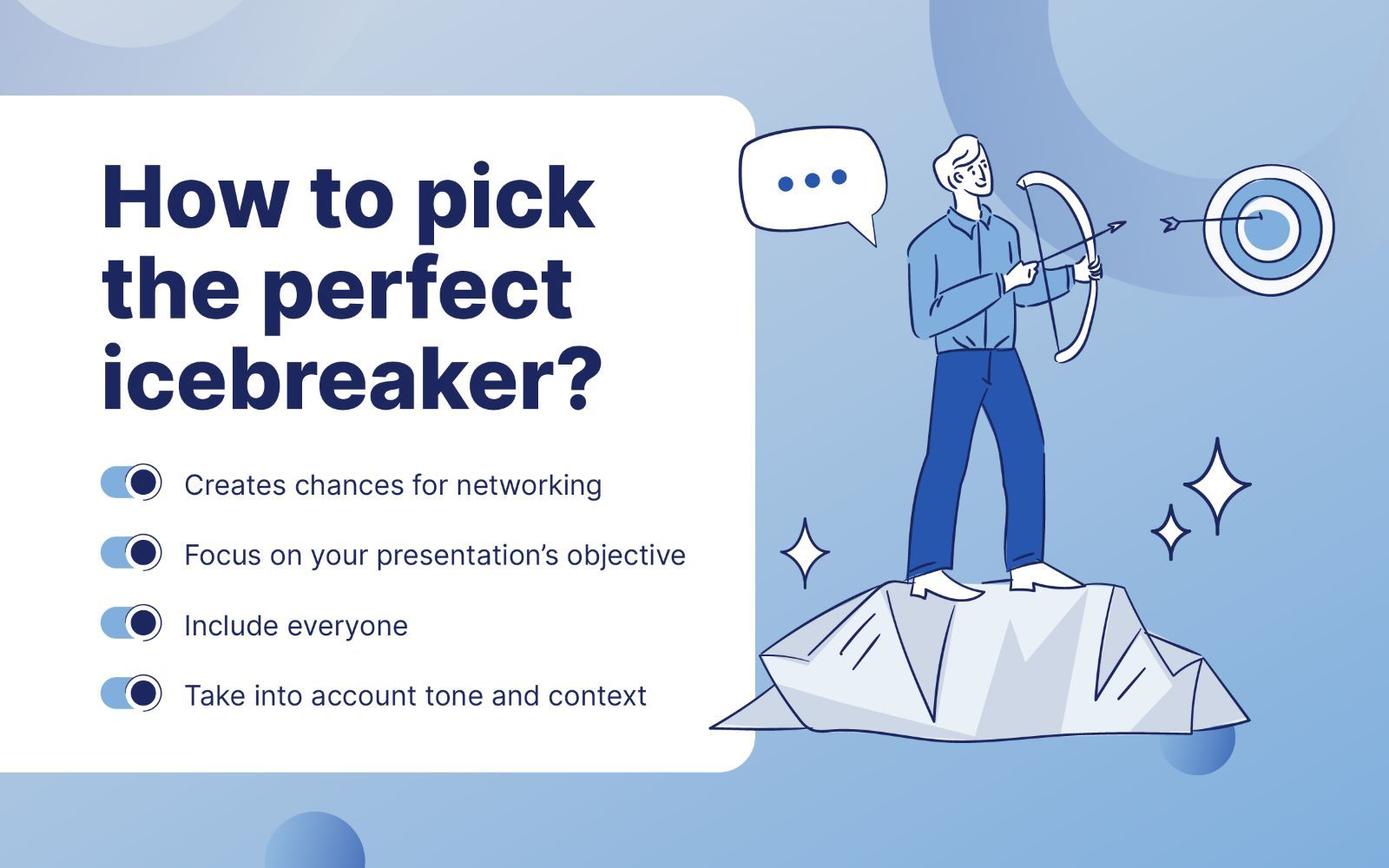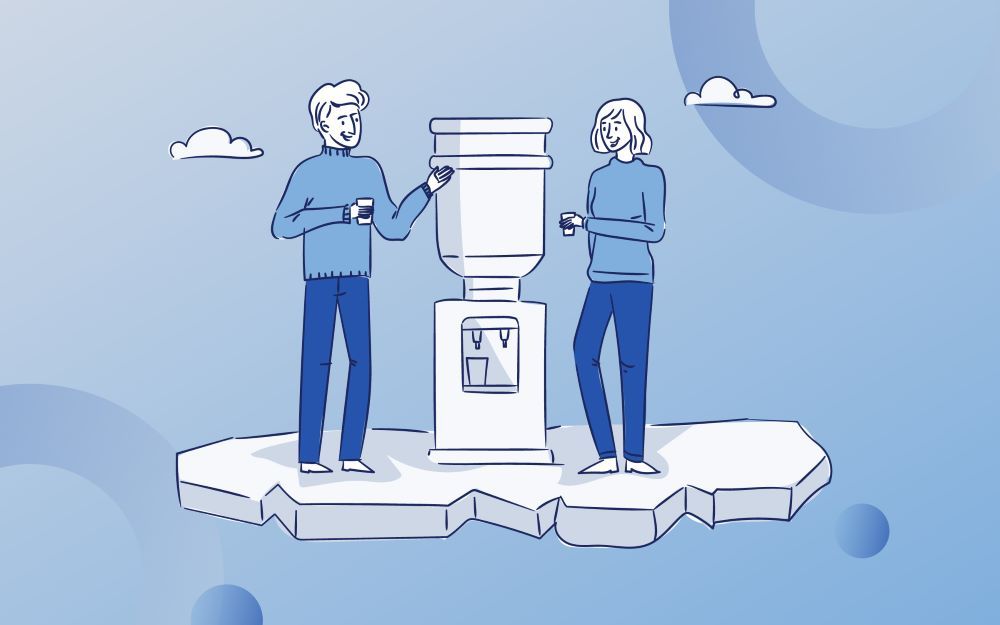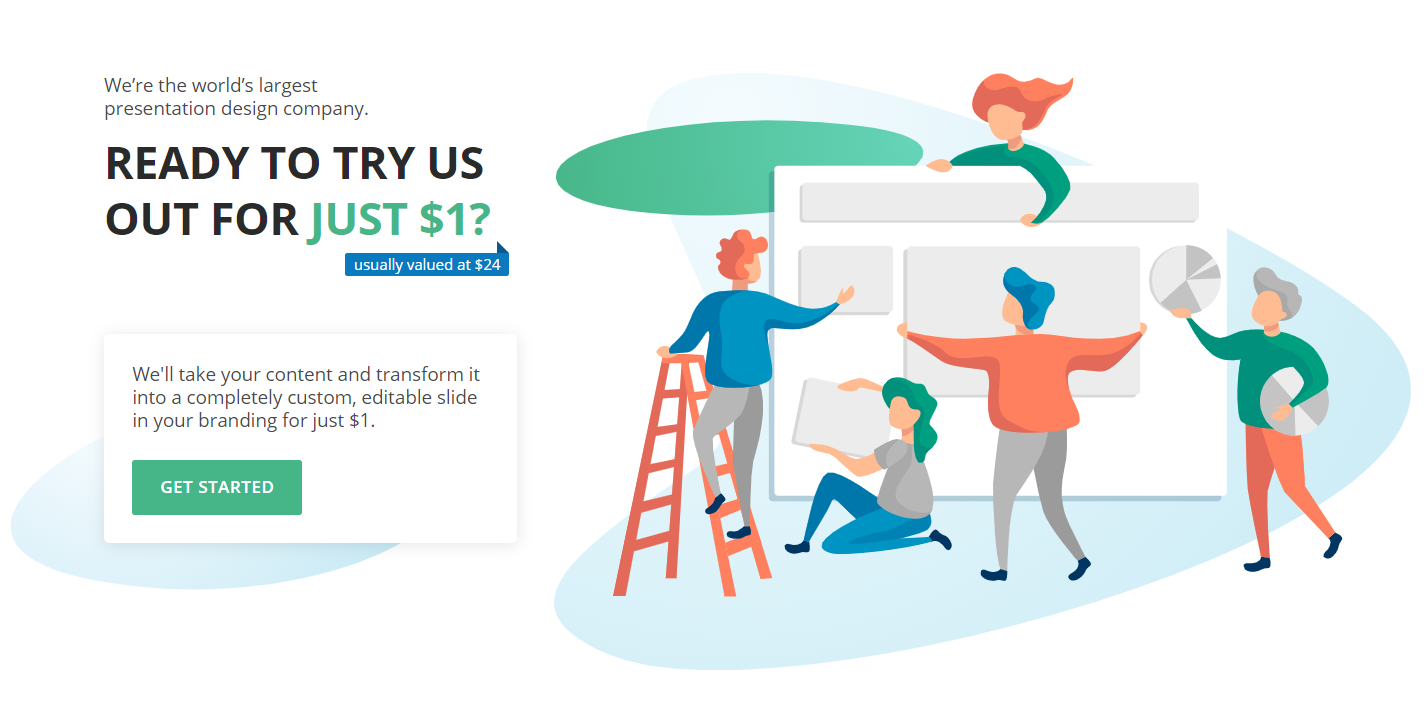50+ Fun Icebreakers For Your Next Presentation
If you’re looking for the perfect icebreaker to open your presentation and connect with your audience from the get-go, look no further! With the help of our presentation experts here at 24Slides, we have compiled the ultimate list of icebreakers you can use in your next presentation, meeting, or conference.
We’ll also go through some quick icebreakers 101, solving questions like:
- What is an icebreaker?
- Why should I start my presentation with an icebreaker?
- What makes a good icebreaker for presentations?
And, of course, you’ll get our compilation of over 50 icebreaker examples for your next presentation. Since there’s no one-size-fits-all, we’ve divided our presentation ice breakers into categories depending on the context of your presentation, so you can go straight to the ones that will work the best for you!
In this article, you’ll find:
- Icebreakers for one-on-one presentations
- Icebreakers for small group presentations (2-10 people)
- Icebreakers for medium group presentations (11-30 people)
- Icebreakers for large groups (31+ people)
- Icebreakers for business and sales presentations
- Icebreaker ideas for training sessions and workshops
- Virtual presentations icebreakers
- Fun icebreaker examples for playful presentations
- Great simple icebreaker questions
So, are you ready to become an expert in using icebreakers in your presentations?

What is an icebreaker?
Imagine you’re in a room with a bunch of people where you know only a few of them or even none at all. You’d probably start feeling awkward and self-conscious, uncertain to interact with those around you. When you’re uncomfortable, your attention will probably be divided between wanting to listen to the speaker and making sure your elbows don’t touch your unknown neighbor.
And, if you’re the speaker, you might feel pretty awkward too. Speaking in front of an audience is never easy, and you might wonder how to approach your presentation’s topic, especially if it’s dense or very important.
An icebreaker is precisely what its name suggests: it breaks the ‘ice’ of uncomfortableness between you and everyone else around you. Icebreakers are usually short activities meant to help your audience to connect first as people before approaching your presentation’s topic - making your audience more relaxed and likely to hear out your ideas.
Icebreakers can take many forms and shapes, from simple questions to engaging games. They can require people to talk with each other, answer a poll, or even move around the room. Anything that will make your attendees open up could be an icebreaker as long as it makes people feel more at ease!
Benefits of icebreakers
The main objective of using an icebreaker in a presentation is to help people get more comfortable and avoid the common awkwardness when first speaking to a new audience.
Icebreakers can accomplish many things - presenting yourself, getting people more at ease, and even as an introduction to your presentation’s topic. But they also offer a wide array of side benefits, like getting people more involved with your presentation and making it more memorable.
If you’re thinking to yourself, ‘Why should I add an icebreaker to my presentation? I’m just fine without one!’ here are 6 of the top benefits of using an icebreaker in your next meeting.
- It breaks down the awkwardness
For people who aren’t 100% an extrovert, presentations and meetings are likely to create a certain degree of awkwardness. And having a room full of people who feel uncomfortable around each other can be detrimental to your presentation. Icebreakers help lessen this feeling in your presentation – making people relax and be more at ease so they can put all their energy into listening.
- Icebreakers help people relax and have fun
When people relax, they’re more likely to entertain new ideas. An icebreaker may be the turning point to make them feel more receptive to what you’re going to say. It also opens up more possibilities for inviting your audience to participate and ask questions. Icebreakers are a great way to make them feel welcomed and more likely to volunteer or join whatever activity you’ve prepared for them onstage.
- Help you connect with your audience
A presentation where the speaker starts right away can feel a little jarring. Icebreakers are the perfect way to introduce yourself and your topic without throwing your audience headfirst into the presentation. A good icebreaker can help you connect better with your audience – making them, in turn, more likely to hear you out!
- Gives your audience an energy boost
Some presentations can feel like they take forever. When you’ve been sitting down for what seems like hours, you might feel yourself starting to nod off. An icebreaker doesn’t necessarily happen just at the start of the presentation. It can be a great way to wake up your audience after a quick break and bring them back to the topic at hand.
- Gives a chance to network with others
The right icebreaker can get your audience talking and help them find things in common. After all, your audience is all in the same meeting for a reason! By giving them the opportunity to interact with one another, you are also giving them the extra value of finding people who can work with them in the future.
And, of course, icebreakers are great ways to get the ball rolling, so by giving your audience a chance to talk with one another, you might also get more interesting and unique takes on questions and ideas later on.
- Creates a positive atmosphere
A positive atmosphere is created when people lower their barriers and defense mechanisms, making it more conducive to learning. A negative atmosphere, on the other hand, is felt when people don’t feel at ease and give their neighbors the cold shoulder. ‘Breaking the ice’ needs to get done as soon as possible!

5 Practical Tips for a Good Icebreaker
What makes a good icebreaker? This is a tricky question to ask. Many icebreakers that work in certain situations will not work in others, as their use depends on context.
Here are key factors to consider when planning your next presentation’s icebreaker:
- Know your audience
Take the time to research your audience. The most important thing when planning your presentation’s icebreaker is to remind that you want your audience to feel less awkward — not more.
Taking your time to learn about the people in front of you is the easiest way to avoid doing or saying something that could potentially offend your audience. Even if you do it unintentionally, the damage will still be done.
- Identify your presentation objective
The right icebreaker will help you achieve your presentation objective, so take some extra time to think about it. For example, if you’re giving a presentation on cooperation and teamwork, you can do a game where your audience needs to rely on one another. Or conduct a poll to ask your audience how confident they are in their teamwork skills.
Making your icebreaker closely relate to your presentation’s topic will not only open up your audience but also allow you to transition smoothly to the rest of your presentation.
- Involve everyone
The icebreaker should be inclusive, meaning it shouldn’t exclude anyone from joining. For instance, if you have a disabled person in the crowd, then you wouldn’t want him or her to feel awkward for not being able to join.
Have a backup icebreaker just in case the first one excludes someone. The point is that fun icebreakers should make everyone feel more at ease — and not at the expense of the outliers of the crowd.
- Make sure you understand the context
To pick the right icebreaker for your presentation, you must know the overall setting in which it will take place. A presentation to the board of directors where you need to explain where the sales have been going down is probably not the best place to use a joke as an icebreaker. Or, if you’re giving a quick 15-minute presentation, you might not want to begin with a game that will take at least 10 of them.
Taking into consideration general setting cues like time frame, space and resources availability, and presentation tone, will help you pick the perfect icebreaker.

The Ultimate Presentation Icebreakers List
Here you’ll find the perfect icebreaker for your presentation. Since not every icebreaker will work on every situation, here you’ll find them divided into several categories:
- Icebreakers depending on your audience size
- Icebreakers depending on your presentation’s tone and context
- Quick and easy questions to break the ice
Do feel free to browse through the entire list: most icebreakers will be easy to adapt to fit your specific needs and your presentation!
Presentation Icebreakers for Every Audience Size
While in a small crowd, you might be able to ask person by person their input, this will most likely not be the case in large groups. On the flip side, a game that needs the audience to divide into teams might be a good pick for a medium-sized crowd, but not a one-on-one presentation.
Among the many options of icebreaker options all over the web, we’ve compiled and edited a list of which ones will work the best for each audience size:
Icebreakers for one-on-one presentations
- Introduce yourself. Unless you already know each other, introducing yourself is the easiest way to look proactive and get your presentation going. After all, it’s in your best interest for your prospect to warm up to you before your pitch or presentation!
- Have a conversation. Don’t go straight to your topic. Always warm up your prospects and engage them in conversation first. Try to ask open-ended (instead of just ‘yes’ or ‘no’) questions. You can tackle topics like current events, or even just the weather! Just talking in a more casual way will make the person feel more at ease and more likely to give you their undivided attention.
- Ask them about their personal life. If it’s someone you already know, build rapport by showing you care about them. You can ask about their kids, vacations, or even their favorite sports team. Remembering what they care about can be a huge plus when building a better atmosphere!
- Let them tell you what they expect from your presentation. It’s the easiest way to make sure you live up to your expectations! It also allows you to introduce the topics of your presentation seamlessly. Even better, you’ll feel and look more confident and under control by taking charge of the presentation’s rhythm and agenda.
- Ask something related to your presentation topic. Ask them if they know anything about your company, product, competitors, or something to that effect. It’s not only a great way to start your presentation without spending too much time on what they already know, but it’ll also help you gauge their knowledge so you can decide how in-depth you need to get in your presentation.
- Give them a small present just for showing up. Especially if the meeting is not an obligation for them, being appreciative if they show up can go a long way. After all, they’re investing their time and energy into you!
- Compliment them. It’s always nice to get compliments. But don’t overdo it, and always, always be genuine. If your prospect feels like you’re using flattery to get the sale, then it can seriously backfire on you later on. You’ll lose face and credibility.
Icebreakers for small group presentations (2-10 people)
- Introductions but with a twist. Ask everyone to introduce themselves and state something unusual or a fun fact about them. Towards the end of the presentation, ask them if they remember anything other people said during the introduction. If they get something right, reward them.
- Ask people to line up alphabetically. You can do this with their first names or last names. Or even their nicknames. This gets people talking and getting to know each other’s names.
- Charades. This is one of the best fun icebreakers on this list. It’s a party favorite but can also be used in presentations, meetings, and conferences. You probably already know how this works, but if not, here’s a funny charades video on Jimmy Fallon’s show.
- String a story together. Storytelling is a powerful element in presentations. But for this icebreaker, you’ll need everyone’s help to create a story. Start the first sentence yourself and then ask the first person in front of you to continue the story. Each person gets to decide the direction the story takes, one sentence at a time.
- Play word games. There are many different kinds of word games. But this is something you may find useful. Identify the subject or category the words should belong to, like animals or food. If the first person chooses ‘DOG,’ the next person must identify an animal that starts with the last letter of the previous word. In this case, it would be something that starts with the letter G, like GOAT.
- One word to describe him or herself. Give your audience one minute to think about the perfect word that describes them. And let the others assess if they agree with that word or not.
- Social media icebreaker. Let people open up their favorite social media accounts and then share a photo they’re most proud of. Ask them to share a line or two about why they love that photo.
Icebreakers for medium group presentations (11-30 people)
- Switcheroo. Ask everyone to stand up and switch seats with the people in front of them. Do this when you notice people are starting to get drowsy and need some stimulation.
- Human bingo. This is a fun way to get to know people. Prepare the cards and the pen/pencil. The cards should already be filled out with various traits, characteristics, hobbies, etc. Then, your participants will need to go around and interview each person and check off a box that applies to them. The person who completes their card first gets a prize.
- Friendly debate. Group your participants into two. One should be the ‘pro’ group and the other is the ‘anti’ group. For instance, you can choose pizza lovers and pizza haters. Give them a few minutes to present their arguments and let the great debate begin!
- Two truths, one lie. Just like the title says, make your participants come up with 3 things about themselves, in which one of them is false. Then, in groups or pairs, the others would have to try and guess which one is the lie. It’s a great icebreaker to make your audience interact more with one another.
- Guess game. Just like the last one, it’s easier to make participants interact with one another through a game. Make everyone write on a piece of paper something fun, like an unlikely hobby or the oddest job they ever had. Your audience must try to guess who wrote which one. It’s not only a fun icebreaker, but it also helps people find out the things they have in common.
- Going to the beach. It’s an easy game, but a fun one! Each person will start by saying ‘I went to the beach and I took…’ plus an object, like a beachball, a towel, or a surfboard. Then, the next person must repeat the same sentence and add a new object to the list. The more people, the more the list will grow, and the first person who forgets an item loses! It’s also a good icebreaker for making attendees learn each other’s names by adding who brought what to part of the list they need to repeat.
- Paper planes. Make your audience write something about themselves on a piece of paper, and then instruct them to make a paper plane out of it and throw it! When they pick up a new paper plane, their goal will be to find the correct person. It’s the perfect icebreaker to get people moving and getting to know each other!
Icebreakers for large groups (31+ people)
- Stretch. This one’s easy and straight to the point, but it does help break the boredom. Ask people to stand up and stretch for a few minutes. You can lead the exercise or play a short video on stage. After this short exercise, you can expect to see a bunch of awake and attentive faces.
- Treasure hunting. Hide a few prized items throughout the venue and send your participants on a treasure hunt. It’s always exciting to look out for a prize! Even better, by making them solve clues, you’d encourage your audience to work on their teamwork skills.
- Stress buster. Hand small slips of paper to everyone and ask them to write down the things that are causing them stress lately. Then, during or after the presentation, ask them to rip it to shreds.
- Snowball fight. Divide your group into two sides, and give each person 3 pieces of paper to crumple. Give them 1 or 2 minutes to try to get as many ‘snowballs’ into the other team’s side. A healthy amount of competitiveness will help you break the ice in no time!
- This or that. Another great icebreaker to highlight the things in common! Ask your audience to stand in the middle of the room, and ask them questions that will make them pick a side of the room. Things like ‘Dogs or cats?’ or ‘Night Owl or Early Bird?’ will have them jumping from one side to the other.

Icebreakers depending on your presentation’s tone
When planning your next icebreaker, you must always take into account the context of your presentation. After all, giving a sales report to your boss is not the same as giving a fun workshop on teamwork.
If you’re looking for the perfect icebreaker for a specific situation, here you might find the one you’re looking for!
Icebreakers for business and sales presentations
If you’re looking for a more professional way to warm up your audience for your work presentations, these icebreakers are the one for you. Most business presentations are more serious and straight to the point, just like these icebreaker ideas!
- Storytelling. This one is the king of icebreakers for business presentations and for a good reason! Storytelling is an incredibly powerful tool to add to your presentations, as it helps to both exemplify your point and connect emotionally with your audience. And of course, this makes it the perfect option to break the ice and get their entire attention from the get-go.
- The highlight of the week. This icebreaker is great for getting your audience into a positive mood. When planning your next business presentation, take some extra time to find something good that happened that week or that month. Maybe you record sales for that month, or you got an exceptionally good review from a customer.
- Would you rather? When planning your sales presentation icebreaker, this one will help to get your potential customer right where you want it. Highlight the value they’ll get from your product, and how they are missing out on it. From our experience, asking, ‘What do you prefer, struggling 5 hours per week on PowerPoint, or getting your presentations done by a professional team of designers in 24 hours or less?’ really puts things into perspective!
- Give kudos. The best way to put people in a good mood is to spread out some positivity! Giving the spotlight to someone who has done outstanding work recently can be a great way to break the ice.
- Brainstorming session. Group brainstorming is another great way to get people to exchange ideas. You hit two birds with one stone – an icebreaker and an idea generator rolled into one!
Icebreaker ideas for training sessions and workshops
The best icebreakers for training presentations and workshops are those that incentivize teamwork and learning skills. These icebreakers will help your team get to know each other better and work together in tandem.
- Live polls. There are many apps that allow your audience to make live polls and display the results immediately. This is a great icebreaker, as it can be as serious or lighthearted as you want. You can use it to ask the audience’s mood, their favorite food, and how much they know about the topic at hand.
- Word cloud. Just like a poll, a word cloud can be a great option to explore what your audience thinks about a prompt or concept you give them and to get the ball rolling. You can make them write down in groups, have them add their ideas to a board, or even make one through an app!
- Problem-solution icebreaker. Present a real or hypothetical problem, and ask people to pitch in their solutions. You can ask them for their input individually, or you can divide them into pairs. As the saying goes, two heads are better than one.
- Finish a puzzle together. This is great for group work as everyone can contribute. For example, you can give them a few pieces each, and they’ll then work as a team to complete the puzzle.
- Pop quiz. This icebreaker is the best to keep your audience on their toes and on a learning mood. You can add it at the end of your presentation, before or after a coffee break, or even at the beginning to see how much previous knowledge your audience has.
Virtual presentation icebreakers
Not sharing a physical space can make breaking the ice even more of a challenge, especially since many icebreaker ideas would not fit an online presentation. So here you’ll find some icebreaker options that are specifically designed for virtual meetings!
- Drawing battle. You don’t have to be a professional artist to enjoy this one! There are many apps and websites that allow you to add this game to your virtual meetings. Just propose a topic and let people try to guess what one of them is drawing! You can even divide them into teams to make it more interesting.
- Try a virtual escape room. If you have time, try giving your audience this challenge to build cooperation and teamwork. It’s not only great for learning to work together but also to have fun and loosen up.
- Count till 20. Your team must try to count to 20 by shouting one number each… but without agreeing in which order they’ll go. This icebreaker will definitely make people wake up, and probably also laugh as they try to avoid talking at the same time.
- Emoji movies. Just like charades, your audience must try to guess the movie or book. But instead of someone acting, they must guess it from the emojis. It’s a great adaptation of a classic game for virtual meetings!
Fun icebreaker ideas for playful presentations
Icebreakers can also help your presentation be more playful and fun! If you like your icebreakers a little silly to make sure people loosen up their inhibitions, then take a look at these ideas.
- The no smiles challenge. If you’re making a fun, playful presentation, a great way to make it even funnier is to tell people smiling and laughing aren’t allowed in your presentation. This will most likely have the opposite effect, making people even more ready to laugh at your jokes!
- Human rock paper scissors. This is a fun, high-energy game, but may not be feasible for older participants. Check this video to see if this is something you can use in your presentation.
- GIFs mood barometer. If you want your audience to be a little bit playful, having them share their mood as a GIF is the perfect way. If you want to keep some control of what they share, you can also use a live poll to give them options to choose from. It’s the perfect lightweight activity that still gives you valuable insights into your audience and their energy levels.
- Bad jokes contest. The only thing funnier than a good joke is an extremely bad one. Have your audience try to use their best dad jokes on each other while avoiding laughing at the jokes of the rest.
10 Great Icebreaker Questions for Any Presentation
Sometimes simpler is better, and the easiest way to get people talking is to ask them to do so! These icebreaker questions will help your audience open up without taking much time or extra preparation.
- If you could have any superpower, what would it be, and what would be your superhero name?
- What's the most random piece of trivia you know and why?
- What is the oddest job you ever had, and how did you end up working there?
- If you could make a reality show, what would it be about?
- What cartoon character would you like to hang out with?
- Where is the most embarrassing place you ever fell asleep?
- If they made a sitcom about your life, what would the theme song be?
- What were the best and worst workshops/meetings/conferences you ever attended?
- If the zombie apocalypse began, what three people in this meeting would you want on your team?
- If you had to teach a class right now, what would the subject be?
As a speaker or presenter, it’s important that you prepare fun icebreakers for your audience. You want people to be comfortable not just with you, but with their neighbors and groupmates as well. The icebreakers in this list are just the tip of the iceberg concerning the wide array of possibilities you can choose from. Don’t be afraid to think outside the box and get creative with your icebreakers!
Need more time to prepare for your presentation? 24Slides has you covered!
Now that you’ve begun thinking about your presentation, and the best way to break the ice with your audience, you might wish to have more time to prepare for it. Luckily, 24Slides can help with that!
You can focus on your presentation’s content and how to make your audience as comfortable as possible, and 24Slides professional designers will tackle the visual aspects of it all. In less than 24 hours, you can get a custom-made, fully editable presentation that will wow your audience and make it even more memorable.





